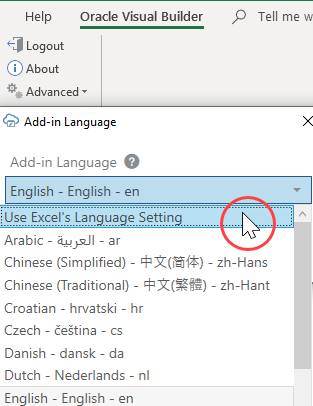8 Internationalization
Oracle Visual Builder Add-in for Excel is available in various languages. It automatically detects the user's preferred language from Microsoft Excel and uses that language where possible.
- Labels visible on the Oracle Visual Builder ribbon and in various windows displayed by the add-in. These labels, known as the add-in labels, are owned by the add-in and are localized.
- Labels visible as column headers and field labels are known as business object field titles. .

Description of the illustration excel-language.png
Note:
Because business object field titles are owned by the service, contact the service owner for any missing translations or languages.Change the Add-in's Language
You can change the language that the Excel add-in uses.
- In Excel, click the Oracle Visual Builder tab.
- Choose Select Language from the Advanced drop-down.
- In the Add-in Language drop-down list that appears, select the language you want to use. The drop-down list displays the languages that the add-in supports.
- Click OK.
- Clear the embedded browser cache. See Clear the Embedded Browser Cache.
- Restart Excel to make your changes take effect.
The add-in's user interface elements (Download Data and so on) now use the language you selected. If the selected language uses a right-to-left writing system, the add-in's user interface elements appear in right-to-left mode. The language that Excel uses remains unchanged, as does the format used for dates, times, and numbers. See Excel or Windows options to change Excel’s language and formats for dates, times, and numbers. See also Natural Language Support in Developing Integrated Spreadsheets Using Oracle Visual Builder Add-in for Excel.
The language that you choose for the add-in language is stored in a local file in the Windows user profile. You can select the Use Excel’s Language Setting option in the Add-in Language drop-down list to remove this setting for the current user.

Description of the illustration excel-choose-lang.png
Refresh All Field Titles
In some cases, you might be able to refresh all field titles if, for example, you want to display field titles in another language.
Imagine you've received an invoices workbook with English as the current language, so all field titles are in English. Now, if you are a data entry user based in France who has Windows and Excel configured for French, you can reset the field titles to see field titles in French as well.
Before you begin, upload any pending changes to your workbook. If you don't, your pending changes will be discarded during the refresh.
When the refresh is complete, the add-in displays the results of the refresh in the Status window.